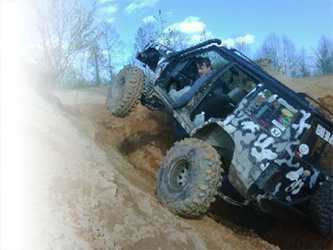I'm borrowing this from another forum just thought I'd share it here. Enjoy Guys
This article is meant to help those who are going snow wheeling.
It is just a general overview and not meant as your only source for being prepared.
Snow wheeling is a blast and for many it’s their most favorite kind of trail riding! Not only do you get to see the beauty of winter, your 4x4 will have a completely different feel on the tail. In deeper snow you’ve have a feeling of floating and basic hills can become un-drivable. If this is your first time wheeling in the snow just make sure you’re well prepared.
First: Do not go alone! Always have a couple other vehicles with you and an organized 4x4 club winter run is great first winter trail ride. Use good common sense & prepare for everything you can. It helps to tell someone where you are going and when you expect to be back.
Second clothes: Don’t be a frostbite victim; make sure you dress for the weather. Do not think because you’ve a good vehicle heater you don’t have to prepare as much, there will be times you have to get out of your 4x4. Hopefully you don’t break, but someone else might and need your help, or someone might get suck and the club might break for lunch.
Have plenty of clothes for all your passengers, to include any pets. Bring extra Dry clothes, you never know what might happen. The difference in wet vs dry clothing cannot be overstated, wet clothes in cold can lead to bad things fast!
Do not wear cotton, it absorbs moisture. Look into fabrics like polypropylene, it wicks moisture away from the body. You can get it inexpensively from box stores, but the really good stuff is made by Patagonia & The North Face.
Good Boots & Wool socks are a must in my book, and don’t forget the mink oil if you’ve leather boots.
Third Vehicle: Make sure your 4x4 off road vehicle has all its maintenance completed and you've it in top shape. Snow driving can and will stress parts much more than other times of the year. Make sure your gas tank if full as the gas pedal is used more in the snow. Lower tire pressure helps in the snow; try the teen’s with normal wheels or even down to 12. For those with bead-locks try single digits. However losing a bead is not fun, so careful with your steering.
Forth Supplies: Bring as much recovery gear as you can carry! Tow straps, or recovery straps are a common item on winter runs. Bring a shovel, blanket, water, and food. Tarps are always a good idea too as you can use them to keep your cloths dry when lying or kneeling in the snow. Chains are ok for later in the season, when the snow is hard packed and ice, they are not recommended for your first few trail rides.
Fifth Driving: If you can't go up hill, do not go downhill; You’ll have to go back up that hill at some point. If you lose forward momentum, don’t stay on the gas; you’ll just make ice or dig yourself a bigger hole to get out of, so back up and hit it again. Most of the time it is easier to be pulled back out the way you went in to the snow. Be alert, the snow can grab a tire quick and send you off your track. Top floatation is key, but there are times when you've got to hammer down on the gas.
Sixth Weather: Expect the weather to change fast. Keep up to date on the forecast and plan for the worst.
Snow: It’s rumored that Eskimos have about 100 words for snow. There are about that many ways to drive in it!
Have fun and stay safe.
Anything I'm missing?








 Reply With Quote
Reply With Quote

Bookmarks